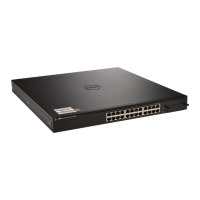820 Configuring Data Center Bridging Features
Ports operating in the manual role do not have their configuration affected by
peer devices or by internal propagation of configuration. These ports have
their operational mode, traffic classes, and bandwidth information specified
explicitly by the operator. These ports advertise their configuration to their
peer if DCBx is enabled on that port. Incompatible peer configurations are
logged and counted with an error counter.
The default operating mode for each port is manual. A port that is set to
manual mode sets the willing bit for DCBx client TLVs to false. Manually-
configured ports never internally propagate or accept internal or external
configuration from other ports; in other words, a manual configuration
discards any automatic configuration. Manually-configured ports may notify
the operator of incompatible configurations if client configuration exchange
over DCBx is enabled. Manually configured ports are always operationally
enabled for DCBx clients, regardless of whether DCBx is enabled.
Operationally enabled means that the port reports that it is able to operate
using the current configuration.
A port operating in the auto-upstream role advertises a configuration, but is
also willing to accept a configuration from the link-partner and propagate it
internally to the auto-downstream ports, as well as receive configuration
propagated internally by other auto-upstream ports. Specifically, the willing
parameter is enabled on the port and the recommendation TLV is sent to the
peer and processed if received locally. The first auto-upstream port to
successfully accept a compatible configuration becomes the configuration
source. The configuration source propagates its configuration to other auto-
upstream and auto-downstream ports. Only the configuration source may
propagate configuration to other ports internally. Auto-upstream ports that
receive internally propagated information ignore their local configuration and
utilize the internally propagated information.
Peer configurations received on auto-upstream ports other than the
configuration source result in one of two possibilities. If the configuration is
compatible with the configuration source, then the DCBx client becomes
operationally active on the upstream port. If the configuration is not
compatible with the configuration source, then a message is logged indicating
an incompatible configuration, an error counter is incremented, and the
DCBx client is operationally disabled on the port. The expectation is that the
network administrator configures the upstream devices appropriately so that
all such devices advertise a compatible configuration.

